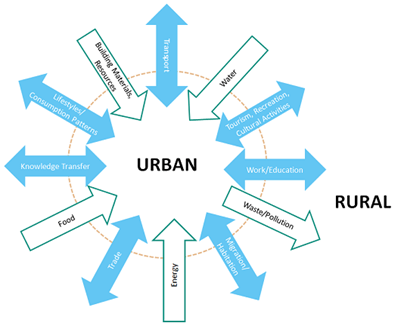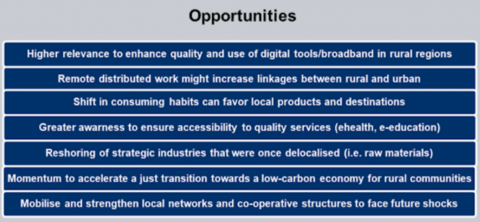Urban-rural innovation linkages

Interreg Europe Policy Learning Platform organised an online discussion on the concept of urban-rural innovation linkages on Tuesday 12 January 2021.
Urban and rural areas have different and often complementary innovation assets. The online discussion explored how better linkages across space (such as flows of people, goods, money, knowledge, and wastes), and linkages between sectors (for example, between agriculture and services and manufacturing) can benefit regional economic development.

Figure 1. Urban-Rural Linkages. Source: Rural Urban Nexus – Global sustainable land use and urbanisation
The concept of urban-rural linkages emerges to respond to the disconnection and dichotomy between rural and urban areas. They tend to be part of different administrative regions with different policy objectives. Policies must therefore develop concepts, instruments, and governance principles, such as urban-rural partnerships, that can address the increasing necessity of integrated planning. Access the
Andres Sanabria, OECD Regional Development and Tourism Division, presented the

Figure 2. Opportunities from the COVID-19 crisis for rural areas and linkages. Source: OECD.
Silvia Barbugian Negro, Lombardy Region, presented the good practice
Some European regions have supported initiatives to connect rural and urban areas. In Next2Met, the project leader, Regional Council of Päijät-Häme (FI), demonstrated the importance of digital networks to enable urban-rural linkages. In CARPE DIGEM, the project leader Digital Nièvre Joint Authority (FR) presented
Marc Pattinson, Thematic Expert in research and innovation, points out that the European Green Deal will offer many opportunities for strengthening urban-rural linkages whether it is the resource dimension or capacity-building to promote regional circular ecosystems. New enabling conditions within the 2021-2027 S3 strategy development process also highlight the need to better address the issues that result in geographical disparities of growth across regions.
Policy Learning Platform resources
- Read the policy brief on
- Read the story on how to foster collaborative spaces in rural areas
- Read the OECD Report on policy implications of COVID-19 crisis for rural development
- Read the news on the European Green Deal
If you have any specific questions related to urban-rural innovation linkages, you can reach out to Policy Learning Platform experts directly via the policy helpdesk.
